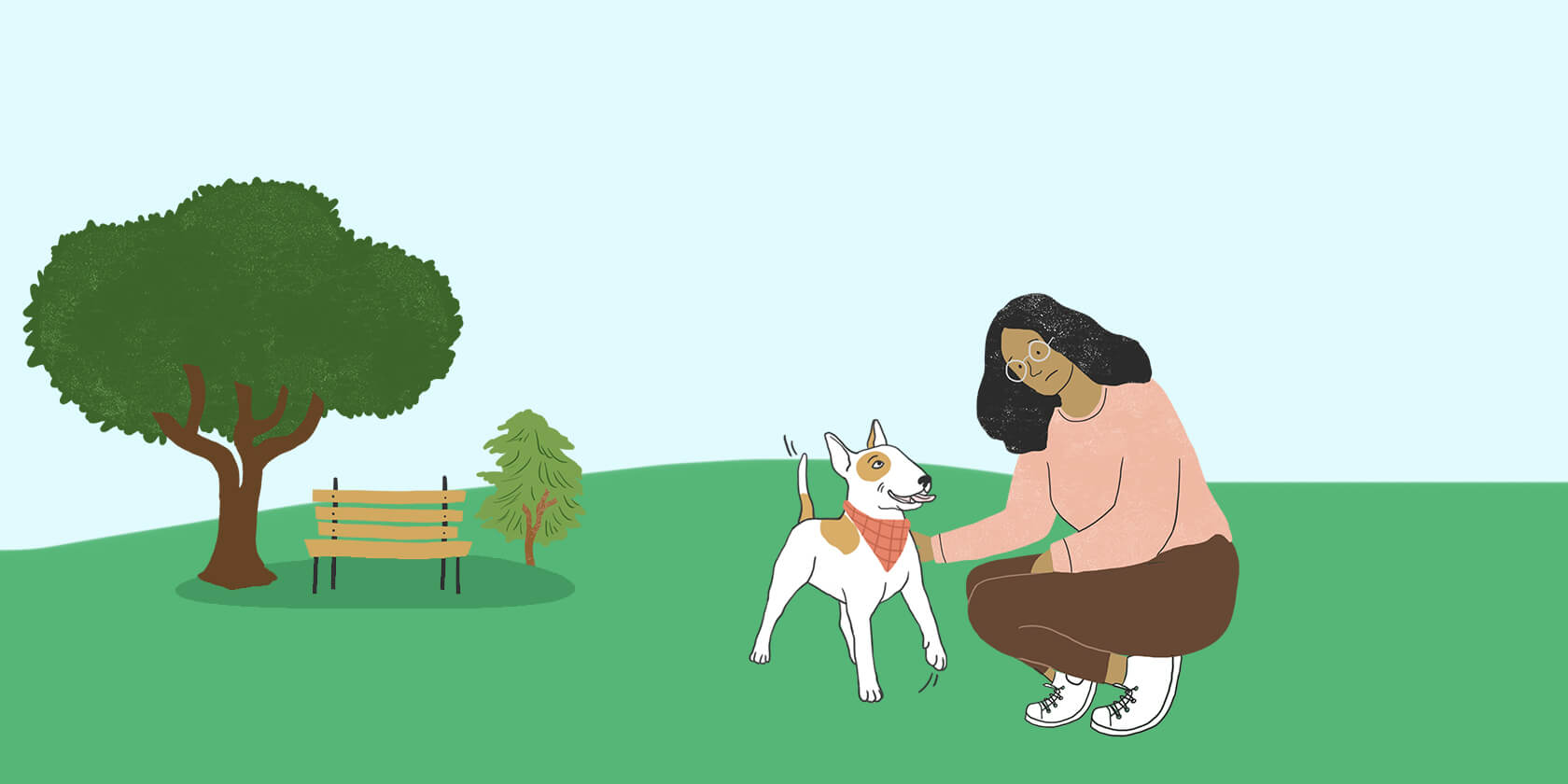Humans and dogs have long shared a bond based on companionship and mutual care. For their part, dogs play an important role in helping to improve the physical and mental wellbeing of humans[1]. In fact, dogs can greatly improve general symptoms of stress and anxiety. Whether as formally trained support animals or simply as loving pets, dogs can provide beneficial effects for people with anxiety.
Dogs and Their Impact on Human Mental Health
Many studies have shown that having a pet can benefit people that are experiencing mental health challenges[1]. The physical contact and companionship that dogs provide has been shown to lower blood pressure[2] and increase hormones that promote mood stabilization and happiness, including dopamine and serotonin[3].
While most dogs can be effective anxiety–reducers for their humans, some are trained specifically for therapy work. Reducing anxiety and providing comfort is quite literally their job. These therapy dogs help those in stressful environments, such as courtrooms, hospitals, or disaster areas, by providing physical contact, interaction, and comfort. Therapy dogs also participate in school programs, helping children build confidence.
Dogs can be trained to alert their owner of an impending anxiety attack or PTSD episode and distract or comfort them to encourage faster recovery[4]. Because of their keen perception and understanding of small changes in human behavior — and maybe even taking advantage of their sense of smell to detect chemical changes — a dog can sense an oncoming anxiety attack and be trained to perform an alert or intervention behavior.

How Dogs Can Help with the Symptoms of Anxiety
Here are just a few ways dogs can offer support to those suffering from anxiety.
Activity. Dogs need physical exercise, and anxiety-sufferers benefit from the increase in exercise[5] as well. Regular dog walks are an easy way to get outside and moving.
Diversion and focus. Dogs need and benefit greatly from training, which provides a positive and productive activity that dog and owner can engage in together. During episodes of anxiety or times of high stress, focusing on training a dog may provide a diversion. Frequent daily interactions with a dog on their own can also provide diversion from anxiety symptoms.
Companionship. Dogs provide a close and consistent relationship for people who may struggle to connect socially, or whose condition prevents them from maintaining regular social interactions.
Connection. Having a dog can encourage time spent around other people and dogs such as participation in dog classes, dog sports, or other activities. This can in turn help an owner build a social network alongside their trusted companion.
Calm. Having a dog can provide comfort after distressing experiences[6]. In fact, some dogs are trained specifically for this purpose. Dogs are particularly attuned to their owners’ emotions and can provide a calming influence when their owner is struggling.
Selecting A Dog to Help with Anxiety
There’s much more to consider than breed alone when selecting a dog to help with anxiety. A dog's ability to act as a support for an owner suffering from anxiety depends on their individual temperament and their owner's specific needs. When choosing a dog to help with anxiety, consider the triggers of anxiety and how a dog might be effective (or ineffective) in providing assistance.
Someone with general anxiety. A dog with behavioral issues, such as separation anxiety or leash reactivity, might be overwhelming to manage — although in some cases, helping a dog overcome behavioral issues can build companionship and increase an owner’s confidence.
Someone with social anxiety and difficulty connecting. A breed known for being sociable, such as a Golden Retriever, might be a good choice. Breeds like this can make it easier to connect with other dogs and in turn other people, as they tend to love being the center of attention. Dogs that tend to be active and social can also encourage their owners to participate in dog–centric classes or activities.
Someone with anxiety around having too much to do. Dog breeds that require lower levels of care when it comes to grooming or physical exercise needs, such as a Pug, might be better for people who feel anxious when they have a lot on their plates.
Someone with anxiety around personal safety. For a person who becomes anxious when alone, a loyal and protective breed, such as a German Shepherd, might provide the safety and security to help them feel comfortable.
Someone with anxiety around loneliness. A dog that enjoys physical proximity and contact with their owner can ease loneliness. Breeds that tend to be affectionate, like the Cavalier King Charles Spaniel, can also provide a constant reminder of companionship.
If you are considering a dog to do therapy work with — for example, in long–term care facilities, schools, or hospitals — you’ll want to look for a dog that has high trainability but a calm disposition, such as a Bernese Mountain Dog or Labrador Retriever. Medium and large breed dogs tend to do well with the increased physical interaction in these roles, but some smaller breed dogs such as a Beagle or Toy Poodle could also thrive as a therapy dog. Proper socialization and diligent training that starts during puppyhood is essential to help these dogs prepare for the sights, sounds, smells, and handling they'll experience in therapy environments.
Above all else, the best dog to support someone with anxiety is one that builds a strong and trusting bond with their human. Dogs of many breeds can be a reliable and loving companion and provide support for your physical, emotional, and mental wellbeing.
Note: Clinical anxiety is a medical diagnosis. Using a dog as part of the management of clinical anxiety should be done under the recommendation and care of a licensed physician.
ZPC-01063R1
- Brooks HL, Rushton K, Lovell K, et al. The power of support from companion animals for people living with mental health problems: a systemic review and narrative synthesis of the evidence. BMC Psychiatry. 2018; 18(1):31. doi: 10.1186/s12888-018-1613-2.
- Levine GN, Allen K, Braun LT, et al. Pet Ownership and Cardiovascular Risk: A Scientific Statement from the American Heart Association. Circulation. 2013;127(23):2353-63. Doi: 10.1161/CIR.0b013e31829201e1.
- Beetz A, Uvnas-Moberg K, Julius H, et al. Psychosocial and psychophysiological effects of human-animal interactions: the possible role of oxytocin. Front Psychol. 2012; 3: 234. Doi: 10.3389/fpsyg.2012.00234.
- Lloyd J, Johnston L, Lewis J. Psychiatric Assistance Dog Use for People Living With Mental Health Disorders. Front Vet Sci. 2019; 6: 166. Doi: 10.3389/fvets.2019.00166.
- Exercise for Stress and Anxiety. Anxiety and Depression Association of America. https://adaa.org/living-with-anxiety/managing-anxiety/exercise-stress-and-anxiety. Accessed February 3, 2021.
- Brooks H, Rushton K, Walker S, et. al. Ontological security and connectivity provided by pets: a study in the self-management of the everyday lives of people diagnosed with a long-term mental health condition. BMC Psychiatry. 2016; 16(1): 409. Doi: 10.1186/s12888-016-1111-3.



